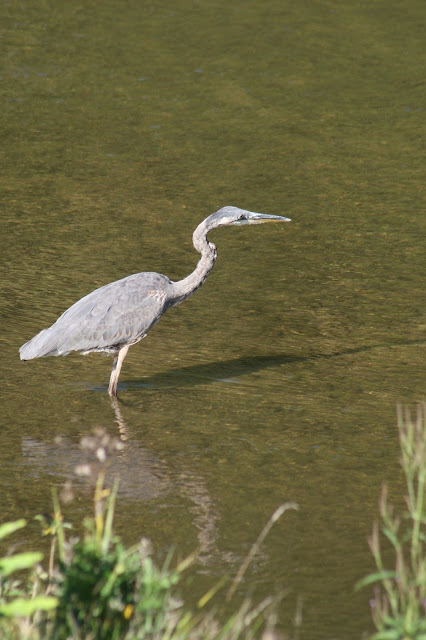 |
| Herons' eyes are located on the sides of their heads - they don't see things directly in front of them all that well. |
This is the Great Blue Heron (Ardea herodias). It is Michigan's second largest bird after the Sandhill Crane. Mature Great Blue Herons can be between 38 and 54 inches tall and have a wingspan of 65 to 79 inches! Having one take flight at close range is always a thrill.
Herons are an ancient group of birds. Although fossils are rare, they have been found dating back as far as 60 million years ago. With their large size and ancient heritage, it is no stretch to see these birds as living dinosaurs.
 |
| A Great Blue Heron wades among water lilies. |
It's even easier to see the connection when you watch them hunting. Great Blue Herons are pure predators. Their long legs allow them to stalk silently through shallow waters and along shorelines. The largest percentage of their diet is composed of fish, but they also eat amphibians, reptiles, small birds, and large invertebrates. Sometimes they can be seen stalking through field in search of mice, voles, and other small mammals. When prey is sited, the heron will curl its long neck and then rapidly extend it to stab with the long spear-like beak. They then swallow their prey whole - often tilting their head skyward to have gravity help the process.
 |
| A Great Blue Heron tilts its head for a better view of its prey. |
The Great Blue Heron is often a year-round resident of Mid-Michigan. Many will remain in the region throughout the winter, unless all surface water is frozen over. Other herons will join in a migration that may take them as far south as Central America or the Caribbean.
 |
| Heron tracks on the Chippewa River ( January 2014) |
During the majority of the year Great Blue Herons are solitary birds. However, in springtime, Great Blue Herons (and related species) will nest in communal nesting colonies called heronries (or heron rookeries). Each heron pair will build a platform of sticks lined with softer materials such as grasses and moss. In an established heronry, the birds will often build upon the work of previous years. Large nests can be 4 feet across and nearly as tall.
 |
| A small heronry in Gratiot County |
 |
| Great Blue Heron in the shallows at Mill Pond Park - scan of a photo from 2005 |
Basic Information
Great Blue Heron
Ardea herodias
No comments:
Post a Comment